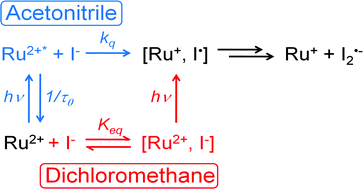Influence of ion pairing on the oxidation of iodide by MLCT excited states
Abstract
The

- This article is part of the themed collection: Contributions of inorganic chemistry to energy research
* Corresponding authors
a
Departments of Chemistry and Materials Science & Engineering, Johns Hopkins University, 3400 North Charles Street, Baltimore, Maryland
E-mail:
meyer@jhu.edu
The

 Please wait while we load your content...
Something went wrong. Try again?
Please wait while we load your content...
Something went wrong. Try again?
B. H. Farnum, J. M. Gardner, A. Marton, A. A. Narducci-Sarjeant and G. J. Meyer, Dalton Trans., 2011, 40, 3830 DOI: 10.1039/C0DT01447H
To request permission to reproduce material from this article, please go to the Copyright Clearance Center request page.
If you are an author contributing to an RSC publication, you do not need to request permission provided correct acknowledgement is given.
If you are the author of this article, you do not need to request permission to reproduce figures and diagrams provided correct acknowledgement is given. If you want to reproduce the whole article in a third-party publication (excluding your thesis/dissertation for which permission is not required) please go to the Copyright Clearance Center request page.
Read more about how to correctly acknowledge RSC content.
 Fetching data from CrossRef.
Fetching data from CrossRef.
This may take some time to load.
Loading related content
